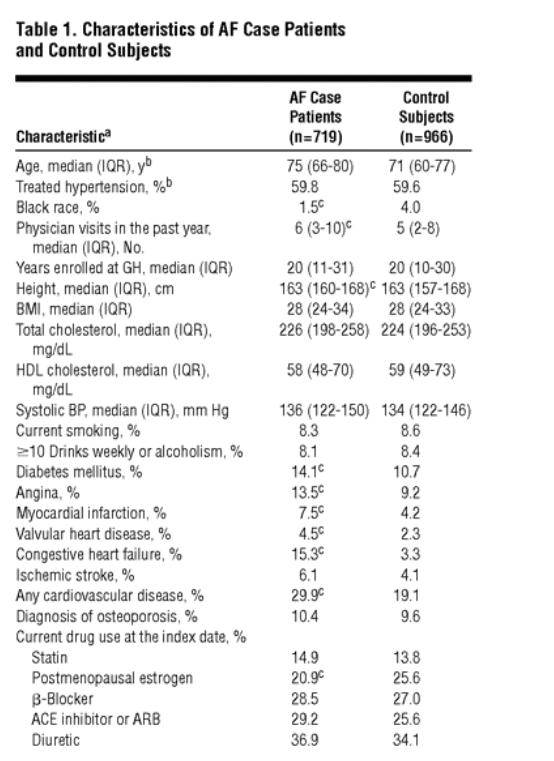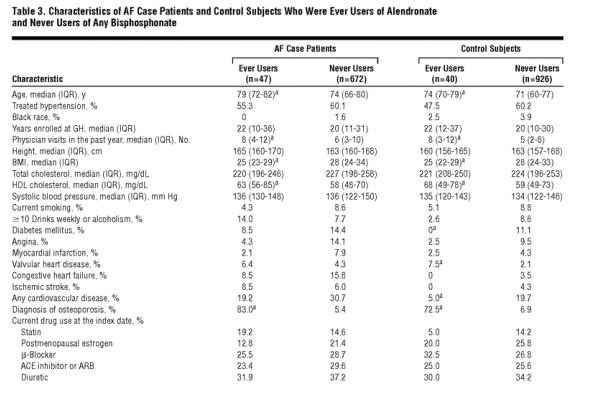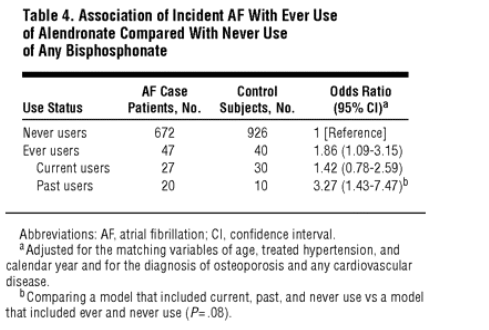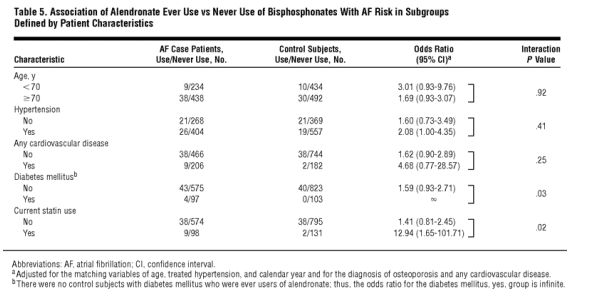| |
Use of Alendronate and Risk of Incident Atrial Fibrillation in Women
|
| |
| |
Arch Intern Med. April 28, 2008;168(8):826-831.
Susan R. Heckbert, MD, PhD; Guo Li, MS; Steven R. Cummings, MD; Nicholas L. Smith, PhD; Bruce M. Psaty, MD, PhD
Author Affiliations: Cardiovascular Health Research Unit (Drs Heckbert, Smith, and Psaty and Mr Li) and Departments of Epidemiology (Drs Heckbert, Smith, and Psaty) and Medicine (Mr Li and Dr Psaty), University of Washington, Seattle; Center for Health Studies, Group Health, Seattle (Drs Heckbert and Psaty); San Francisco Coordinating Center, California Pacific Medical Center Research Institute and University of California, San Francisco (Dr Cummings); and Seattle Epidemiologic Research and Information Center, Veterans Administration Puget Sound Health Care System, Seattle (Dr Smith).
ABSTRACT
Background: A recent publication from the HORIZON (Health Outcomes and Reduced Incidence With Zoledronic Acid Once Yearly) trial in women with postmenopausal osteoporosis reported a higher risk of serious atrial fibrillation (AF) in zoledronic acid recipients than in placebo recipients. This adverse effect was unexpected and had not been recognized previously.
Methods: We studied alendronate sodium ever use in relation to the risk of incident AF in women in a clinical practice setting. This population-based case-control study was conducted at Group Health, an integrated health care delivery system in Washington State. We identified 719 women with confirmed incident AF between October 1, 2001, and December 31, 2004, and 966 female control subjects without AF, selected at random from the Group Health enrollment and frequency matched on age, presence or absence of treated hypertension, and calendar year.
Results: More AF case patients than controls had ever used alendronate (6.5% [n = 47] vs 4.1% [n = 40]; P = .03). Compared with never use of any bisphosphonate, ever use of alendronate was associated with a higher risk of incident AF (odds ratio, 1.86; 95% confidence interval, 1.09-3.15) after adjustment for the matching variables, a diagnosis of osteoporosis, and a history of cardiovascular disease. Based on the population-attributable fraction, we estimated that 3% of incident AF in this population might be explained by alendronate use.
Conclusion: Ever use of alendronate was associated with an increased risk of incident AF in clinical practice.
INTRODUCTION
A recent publication1 from the HORIZON (Health Outcomes and Reduced Incidence With Zoledronic Acid Once Yearly) trial of once-yearly zoledronic acid for postmenopausal osteoporosis reported an unexpected adverse effect: a higher risk of serious atrial fibrillation (AF) in zoledronic acid recipients than in placebo recipients (50 [1.3%] vs 20 [0.5%] patients; P < .001). A similar finding was reported from the Fracture Intervention Trial of alendronate sodium for osteoporosis; the risk of serious AF events was higher in alendronate recipients than in placebo recipients (47 [1.5%] vs 31 [1.0%] patients; P = .07), but this difference did not reach statistical significance.2 The adverse effect of AF was not previously reported in users of bisphosphonates. We used data from the population-based Group Health Atrial Fibrillation Study to examine whether alendronate use was associated with risk of incident AF in women in a clinical practice setting.
COMMENT
In this case-control study, the risk of incident AF was higher in women who were ever users of alendronate than in never users of bisphosphonates. We did not find evidence of a dose-response relationship according to the number of grams of alendronate dispensed or the interval since first prescription. Alendronate was more strongly associated with AF that was sustained during the first 6 months after clinical recognition than with AF that was transitory or persistent/intermittent, and the risk of AF associated with alendronate use was higher in patients with diabetes mellitus and in patients taking statins than in those without these characteristics. Because alendronate use was relatively rare in this population, the proportion of incident AF that might be explained by alendronate use was small.
The strengths of this study include the large number of AF case patients, the population-based design, the validation of incident AF, the inclusion of case patients presenting in outpatient and acute care settings, the comparable ascertainment of potential confounding factors, the use of the GH pharmacy database to assess alendronate use in an unbiased manner, and the availability of detailed information on dose, duration, and timing of alendronate use. Restriction, stratification, and adjustment were used to minimize the possibility of confounding. All the participants were enrollees of a health maintenance organization and, thus, had similar access to health care.
Nevertheless, this study was observational, and patients were not assigned alendronate use at random. There may have been unknown or unmeasured confounding factors for which adjustment was not possible. Measurement error in the assessment or estimation of covariates and their severity may have resulted in incomplete adjustment and residual confounding. Ascertainment of AF may not have been complete because we were able to identify only AF case patients who came to clinical attention. Few patients used bisphosphonates other than alendronate, so this study could not address the possibility of a similar association with other bisphosphonates. We did not examine the risk of AF associated with bisphosphonate use in men. Finally, the number of alendronate users in some subgroups was small. In particular, the findings regarding increased risk in patients with diabetes mellitus and those taking statins require confirmation, and power was limited to draw conclusions about the risk of AF detected in acute care vs outpatient settings and for risk associated with current vs past use of alendronate.
Atrial fibrillation was not recognized as a possible adverse effect of bisphosphonates11 until the recent studies from the HORIZON trial of zoledronic acid1 and the Fracture Intervention Trial of alendronate.2 In those studies, there was a higher rate of serious adverse events of AF, but not all AF, in bisphosphonate recipients than in placebo recipients. In contrast, in the present study, which was designed specifically to study AF, alendronate use was associated with an increased risk of AF overall and specifically for AF diagnosed in an acute care setting. In the clinical trials, the finding of an association with serious adverse events of AF, but not all AF events, might be owing to more accurate diagnosis of the arrhythmia when patients are hospitalized, prompting centralized review of the medical records, whereas nonserious adverse events can be based on self-report or less rigorous clinical data. The present study rigorously confirmed all cases regardless of the health care setting.
In the HORIZON trial, most AF events occurred more than 30 days after the zoledronic acid infusion, and in the Fracture Intervention Trial, the AF risk seemed to be elevated throughout the average 4 years of follow-up, suggesting that AF was not an acute adverse effect. Consistent with that finding, in the present analysis, AF risk was not higher in current users than in past users of alendronate.
The potent nitrogen-containing bisphosphonates, such as zoledronic acid and alendronate, are known to inhibit protein prenylation, thus disrupting the function of key regulatory proteins.12 Bisphosphonates accumulate in bone, where they persist for years and are detectable in body fluids for at least several months after administration.12 An acute syndrome of fever and elevation of tumor necrosis factor {alpha} and interleukin 6 levels for 1 to 2 days commonly follow intravenous administration of bisphosphonates13; less is known about long-term effects on inflammatory markers. Several authors14-16 have hypothesized that inflammation is related to atrial remodeling and fibrosis and may be involved in the pathogenesis of AF. Bisphosphonates can cause small decreases in serum calcium and phosphate levels.17-19 The atrium is sensitive to fluxes in calcium concentration,20 but whether bisphosphonates have an effect sufficient to affect atrial conduction is uncertain. More information is needed about whether bisphosphonates could have effects on atrial tissue in the long term through these or other mechanisms that favor the initiation or persistence of AF.
Bisphosphonates differ in their affinity for binding with bone. Zoledronic acid binds most strongly, followed, in order, by alendronate, ibandronate sodium, and risedronate sodium.12 A recent analysis21 of combined data from several clinical trials of risedronate found no increase in AF adverse events, in contrast to the findings to date for zoledronic acid and alendronate. Further studies are needed to determine whether the association with AF varies by the bone-binding affinity of bisphosphonates.
In conclusion, all drugs have benefits and adverse effects. Bisphosphonates reduce the risk of fracture; in particular, alendronate has been shown to reduce the risk of vertebral, hip, and nonspine fractures in women with osteoporosis.1, 22-23 When new information becomes available about a previously unrecognized benefit or adverse effect, physicians and patients must reweigh the current knowledge about benefits and risks in making treatment decisions for each patient. The benefits of fracture prevention in patients at high risk for fracture will generally outweigh the possible risk of AF. However, it is important to carefully weigh the benefits against the possible risk of AF in women who have only modestly increased fracture risk and in women who have risk factors for AF, such as diabetes mellitus, coronary disease, or heart failure.
RESULTS
CHARACTERISTICS OF CASE PATIENTS AND CONTROLS
We identified all female AF case patients (n = 727) and controls (n = 1057) with index dates during the study period. We excluded from the control group those with a history of AF (n = 77) and those with a pacemaker (n = 3) before the index date to match the exclusion criteria for the case patients. We also excluded 8 AF case patients and 11 controls who had ever used a bisphosphonate other than alendronate during GH enrollment, leaving 719 AF case patients and 966 controls for analysis. The median age was 75 years for case patients and 71 years for controls, and the median duration of GH enrollment was 20 years (Table 1). As expected, AF case patients had a higher prevalence before the index date of diabetes mellitus, angina, MI, valvular heart disease, and congestive heart failure than controls. The prevalence of osteoporosis was similar in case patients and controls (10.4% vs 9.6%).

ALENDRONATE USE
Alendronate is the preferred drug on the GH formulary for the treatment of osteoporosis; other bisphosphonates are available with previous authorization. More AF case patients than controls had ever used alendronate (6.5% [n = 47] vs 4.1% [n = 40]; P = .03) (Table 2). The proportion with current use at the index date was similar in AF case patients and controls, whereas the proportion with past use was higher in AF case patients than in controls (2.8% vs 1.0%; P = .01).
CHARACTERISTICS ASSOCIATED WITH ALENDRONATE USE IN CASE PATIENTS AND CONTROLS
In case patients and controls, ever users of alendronate differed from never users in many respects (Table 3). Alendronate use was associated with older age, substantially lower body mass index, and higher high-density lipoprotein cholesterol levels, and fewer users had diabetes mellitus or any cardiovascular disease. A diagnosis of osteoporosis had been made in most alendronate users and in few never users.

RELATIONSHIP OF ALENDRONATE USE TO RISK OF INCIDENT AF
Ever use of alendronate was associated with an increased risk of incident AF after adjustment for the matching variables, a diagnosis of osteoporosis, and any cardiovascular disease (odds ratio [OR], 1.86; 95% confidence interval [CI], 1.09-3.15) (Table 4). Further adjustment for all other variables significant in Tables 1 and 3, including race, number of physician visits in the year before the index date, height, body mass index, diabetes mellitus, valvular heart disease, high-density lipoprotein cholesterol level, and estrogen use, did not materially change the estimated OR (OR, 1.83; 95% CI, 1.04-3.24). The ORs were slightly higher for past users than for current users, but this difference did not reach significance (test for difference in ORs, P = .08) (Table 4). In sensitivity analyses with an assumption of 100% compliance with prescribing instructions rather than 80%, results were similar to those given in Table 4. There was no evidence of a difference in AF risk according to the total cumulative grams of alendronate dispensed (< 3.9 g [the median] vs ≥ 3.9 g: OR, 1.84 [95% CI, 0.94-3.60] and 1.87 [95% CI, 0.94-3.73], respectively) or according to the interval since first prescription of alendronate (< 2.1 years [the median] vs ≥ 2.1 years: OR, 1.57 [95% CI, 0.81-3.07] and 2.21 [95% CI, 1.12-4.37], respectively). Based on the population-attributable fraction, we estimated that 3.0% (95% CI, 0.4%-5.6%) of incident AF in this population might be explained by alendronate use.

Of the 719 AF case patients, 299 (41.6%) had transitory AF, 328 (45.6%) had persistent/intermittent AF, and 83 (11.5%) had sustained AF during the first 6 months after presentation; AF classification could not be determined in 9 case patients (1.3%). The risk of sustained AF associated with alendronate ever use was higher than the risk of transitory or intermittent AF (sustained AF: OR, 5.75 [95% CI, 2.50-13.25]; transitory AF: OR, 1.93 [95% CI, 0.95-3.92]; and intermittent AF: OR, 1.25 [95% CI, 0.64-2.44]; test of difference in ORs across strata, P = .005). We did not detect a difference in the risk of AF in an outpatient setting (33.3% of case patients: OR, 1.57; 95% CI, 0.80-3.11) vs an acute care setting (66.7% of case patients: OR, 2.14; 95% CI, 1.18-3.89) (test of difference in ORs, P = .39).
Risk of AF associated with alendronate use did not differ in subgroups defined by age, presence of treated hypertension, or history of cardiovascular disease (Table 5). Risk of AF associated with alendronate use was higher in patients with vs without diabetes mellitus (P = .03) and in those currently taking vs not taking statins (P = .02).

METHODS
STUDY SETTING
This ongoing case-control study of risk factors for incident AF3 is conducted at Group Health (GH), a large integrated health care delivery system in Washington State. The GH human subjects review committee approved the study procedures. Waiver of consent was granted for patients with language or cognitive difficulty and for patients who had died. All other participants provided verbal consent by telephone or written consent.
STUDY PARTICIPANTS
We identified GH enrollees assigned an International Classification of Diseases, Ninth Revision, code for AF (427.31 [AF] or 427.32 [atrial flutter]) during any inpatient or outpatient visit between October 1, 2001, and December 31, 2004, who had never before been assigned an International Classification of Diseases, Ninth Revision, code for AF during their enrollment at GH. Control subjects were shared between this study and companion case-control studies of myocardial infarction (MI), stroke, and venous thrombosis at GH.4-6 Controls were chosen at random from GH enrollment lists and were frequency matched to the largest of the case groups, MI cases, by age (by decade), presence or absence of treated hypertension, and calendar year. We defined an index date for all the participants as the date the AF came to clinical attention for case patients or a random date within the range of the case index dates for controls. Eligible participants were women aged 30 to 84 years with at least 4 health care visits before the index date.
DATA COLLECTION
The GH ambulatory medical record includes notes from primary care and specialty physician visits, emergency department visit notes, discharge summaries, information from telephone contacts, electrocardiograms, and laboratory and diagnostic test reports. Trained abstractors reviewed the medical records, covering a median of 20 years of clinical care before the index date, in an identical manner for case patients and controls. Abstractors recorded the presence of diabetes mellitus, hypertension, osteoporosis, congestive heart failure, valvular heart disease, MI, angina, stroke, peripheral vascular disease, revascularization procedures, cholesterol levels, height, and the most recently measured blood pressure and weight before the index date. In telephone interviews, participants were asked about race (to provide demographic information about the study population), smoking status, and alcohol consumption before the index date. For participants who did not complete a telephone interview (48.3%), these data were obtained from medical record review. Information on bisphosphonate, statin, _-blocker, angiotensin-converting enzyme inhibitor, and postmenopausal estrogen use during enrollment came from the GH automated pharmacy database.
An AF diagnosis was verified if the medical record documented a diagnosis of AF by electrocardiogram and clinical recognition of the diagnosis by a physician, with no previous evidence of AF in the medical record. Postoperative AF was included only if it persisted to the time of hospital discharge, and AF as part of a terminal hospitalized illness was excluded.
AF CLASSIFICATION
For AF case patients, we defined categories to describe the duration and persistence of AF (AF classification) during the first 6 months after clinical recognition using evidence available in the medical record.7 The AF case patients were classified into 3 mutually exclusive groups based on the pattern of AF: transitory, persistent/intermittent, or sustained AF. This classification scheme closely followed that of the American College of Cardiology/American Heart Association/European Society of Cardiology (ACC/AHA/ESC) guidelines,8 but some modifications were required because we were evaluating AF patterns across 6 months rather than at a single point in time. Transitory AF was defined as a single episode of AF lasting 7 days or less, without recognized recurrence of AF during the next 6 months. The AF was classified as persistent/intermittent if the initial AF episode lasted more than 7 days or if AF recurred but sinus rhythm was also present during the next 6 months (similar to the ACC/AHA/ESC categories of persistent and paroxysmal). The AF was classified as sustained if the patient was continuously in AF during the 6 months after AF onset (similar to the ACC/AHA/ESC category of permanent). Case patients were further classified as to whether the AF diagnosis was made in an outpatient setting or in an acute care setting, which included an urgent care clinic, emergency department, or hospital admission.
MEDICATION USE
Since 1977, the pharmacy database has included a record for each prescription dispensed by a GH pharmacy. Of patients in this age group, 95.5% of GH members report filling all or almost all prescriptions through GH pharmacies.9 Each pharmacy record includes the drug type and dose, quantity dispensed, and intended days' supply of the prescription.
Ever use of alendronate was defined as the receipt of at least 2 alendronate prescriptions. To determine current use of any particular medication at the index date, we searched the pharmacy data for the prescription immediately preceding the index date. If the patient received enough pills to last until the index date, assuming 80% compliance with prescribing instructions, then the patient was considered to be a current user of the drug. The total amount of alendronate used during GH enrollment up to the index date was determined by summing the milligrams of drug dispensed at each fill (pill strength multiplied by number of pills). Time since first use of alendronate was calculated as the interval, in years, between first use and the index date.
DATA ANALYSES
Diabetes mellitus was defined by a physician diagnosis in the medical record and use of insulin or an oral hypoglycemic agent before the index date. Osteoporosis was defined by a physician diagnosis before the index date. Cardiovascular disease was defined as a history of MI, coronary revascularization, angina, stroke, transient ischemic attack, carotid endarterectomy, claudication, peripheral vascular surgery, or congestive heart failure before the index date.
Multivariate logistic regression with robust variance estimation was used to examine the adjusted risk of new-onset AF associated with ever use of alendronate, the primary study question. Preplanned secondary analyses were conducted in subgroups defined by age, hypertension, any cardiovascular disease, diabetes mellitus, and current statin use. Polytomous logistic regression was used in secondary analyses to examine the relationship of alendronate use to the 3 AF classes (transitory, persistent/intermittent, and sustained AF) and to the setting in which AF was clinically recognized (outpatient vs acute care). Models were adjusted for the matching variables of age (as a continuous variable, with age measured finely in terms of days), treated hypertension, and calendar year and other potentially confounding characteristics. The population-attributable fraction was calculated to estimate the AF incidence in this population that might be explained by alendronate use.10 All the analyses were conducted using a software program (Stata 8.2; Stata Corp, College Station, Texas).
|
|
| |
| |
|
|
|